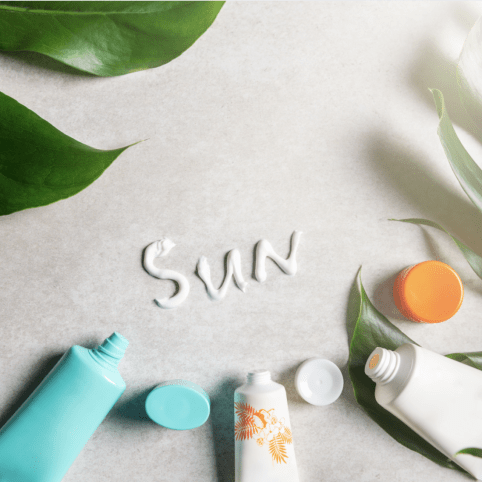The best sun protection is prevention. Here are some tips:
- Wear a hat.
- Take breaks and find some shade.
- Put on broad-spectrum sunglasses to protect your eyes.
- Use a lip balm with SPF protection.
- Avoid sun between 10:00 am and 2:00 pm: this is when the UV peak is highest.
- Consider applying sunscreen after 10-30 minutes of “non-protected” sun exposure to optimize vitamin D synthesis.
- Sensible sun exposure guidelines are based on latitude, season, time of day, altitude, and skin sensitivity, i.e., degree of skin pigmentation.
- The rule of thumb is to be exposed to an amount of sunlight that is about 50% of what it would take to cause a mild sunburn i.e., slight pinkness to the skin 24 h later.
- PMID: 24494042
- Choose a CLEAN & SAFE sunscreen.
What to look for in your sunscreen:
1. A rating of 1 or 2 on the EWG’s Skin Deep Database.
The Environmental Working Group is a great place to see if your household products, personal and cosmetic products are safe to use. Simply type in the name and see the EWG rating. Opt for something that has a rating between 1-2!
2. Mineral based > chemical based sunscreen.
Chemical sunscreens
- Pros:
- Quick and easy to apply
- Does not leave a white film
- Cons:
- Often contains dangerous chemicals and ingredients that can disrupt our hormones, cause skin irritation and allergic reactions.
Mineral (physical) sunscreens
- Pros:
- Contain the active ingredients of zinc oxide and/or titanium dioxide, which act as a PHYSICAL barrier to the UVA/UVB rays from the sun.
- Offers immediate protection from the sun, do not need to way 20-30 minutes to absorb into the skin.
- They are safer and less likely to cause an allergic reaction.
- Cons:
- Harder to apply as they tend to be thick in consistency
- Tends to leave a white film on the skin
- May aggravate acne
- PROTECT OUR OCEANS: look for a non-nano zinc-based sunscreen to keep our oceans safe and happy!
3. Avoid dangerous chemicals.
Chemicals and ingredients found in many health/beauty productscan disrupt your hormones, cause allergic reactions and long-term health effects. These include:
- Oxybenzone
- Retinyl palminate
- Parabens
- Phthalates
- PEG
- Parfum (a.k.a. fragrance)
- Sodium lauryl/laureth sulphate
4. Broad spectrum and SPF.
Choose a product that is labelled “broad-spectrum“. You want something that protects you from both UVA (wrinkle-causing rays) and UVB (sun burns and cancer-causing rays). Choose products with an SPF of 30 or higher.SPF of 30 blocks 97% of the suns harmful rays. Higher SPF does not mean better. Re-apply frequently!
